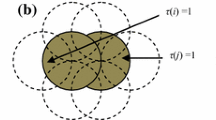Abstract
Event critical applications demand blanket coverage. On the other hand, nodes closer to the base station are exploited as they have to spend additional energy in relaying data of far away nodes. This brings in the idea of implementing blanket coverage in heterogeneous wireless sensor networks. I-DEEC improvises distributed energy efficient clustering (DEEC) by deploying network nodes in two layers. Layer 1 strategically tessellate hexagons to deploy nodes as normal or super nodes based on distance from the base station, considering the high data requirement within hop distance around the base station. Layer 2 randomly deploys advanced nodes with condition that no two advanced nodes sense the same area. Further, it uses the sum of the ratio of node’s distance to the base station along with residual energy ratio to calculate the possibility of a node to be selected as a cluster head, followed by the selection of the optimal percentage high possibility nodes as cluster heads. I-DEEC provisions blanket coverage by extending the stability period by reducing the ratio between initial energy of different types of nodes. I-DEEC revamps DEEC protocol in terms of network lifetime, percentage area coverage, throughput, and residual energy.




Similar content being viewed by others
References
Abdollahzadeh S, Navimipour NJ (2016) Deployment strategies in the wireless sensor network: a comprehensive review. Comput Commun 91–92:1–16. https://doi.org/10.1016/j.comcom.2016.06.003
Andersen T, Tirthapura S (2009) Wireless sensor deployment for 3d coverage with constraints. In: Proceedings of sixth international conference on networked sensing systems at Pittsburg Carnegie Mellon University
Anuradha D, Srivatsa SK (2019) Energy effectual reconfigurable routing protocol (E2R2P) for cluster based underwater wireless sensor networks. J Ambient Intell Human Comput. https://doi.org/10.1007/s12652-019-01413-z
Bhola J, Soni S, Cheema GK (2019) Genetic algorithm based optimized leach protocol for energy efficient wireless sensor networks. J Ambient Intell Human Comput. https://doi.org/10.1007/s12652-019-01382-3
Chakrabarty K, Iyengar SS, Qi H, Cho E (2002) Grid coverage for surveillance and target location in distributed sensor network. IEEE Trans Comput 51:1448–53
Chieh K, Liu BH, Tsai MJ (2011) The critical-square grid coverage problem in wireless sensor network is np-complete. Comput Netw 55:2209–2220. https://doi.org/10.1016/j.comnet.2011.03.004
Gupta P, Sharma AK (2019) Designing of energy efficient stable clustering protocols based on BFOA for WSNS. J Ambient Intell Human Comput 10(2):681–700
Heinzelman W, Chandrakasan AP, Balakrishnan H (2002) An application specific protocol architecture for wireless microsensor networks. IEEE Trans Wirel Commun 1(4):660–670
Kumar D (2014) Performance analysis of energy efficient clustering protocols for maximizing lifetime of wireless sensor networks. IET Wirel Sens Syst.http://dx.doi.org/iet-wss.2012.0150
Li J, Mohapatra P (2005) An analytical model for the energy hole problem in many to one sensor networks. IEEE (0-7803-9152-7)
Liu M, Cao J, Chen G, Wang X (2009) An energy aware routing protocol in wireless sensor networks. Sensors 9:445–462. https://doi.org/10.3390/s90100445
Melissen JBM, Schuur PC (2000) Covering a rectangle with six and seven circles. Dicrete Appl Math 99:149–156
Nurmela KJ, Ostergard PRJ (2000) Covering a square with up to 30 equal circles. HUT-TCS-A62 Espoo
Priyadarshini RR, Sivakumar N (2019) Enhancing coverage and connectivity using energy prediction method in underwater acoustic wsn. J Ambient Intell Human Comput 1–10
Qing L, Zhu Q, Wang M (2006) Design of distributed energy efficient clustering algorithm for heterogeneous wireless sensor networks. Comput Commun 29:2230–2237
Rebai M, Berre ML, Snoussi H, Khoukhi L (2015) Sensor deployment optimization methods to achieve both coverage and connectivity in wireless sensor networks. Comput Oper Res. https://doi.org/10.1016/j.cor.2014.11.002
Sharma V, Patel RB, Bhadauria HS, Prasad D (2016) Deployment schemes in wireless sensor network to achieve blanket coverage in large scale open area: a review. Egypt Inform J 17:45–56. https://doi.org/10.1016/j.eij.2015.08.003
Singh S (2017) Energy efficient multilevel network model for heterogeneous wsns. Eng Sci Technol Int J 20(1):105–115
Singh S (2019) A proficient node deployment mechanism using adjustable sensing range in wireless sensor networks. Iran J Sci Technol Trans Electr Eng 43(1):191–199
Singh S, Malik A (2017a) hetdeec: heterogeneous deec protocol for prolonging lifetime in wireless sensor networks. J Inf Optim Sci 38(5):699–720
Singh S, Malik A (2017b) hetsep: heterogeneous SEP protocol for increasing lifetime in wsns. J Inf Optim Sci 38(5):721–743
Singh S, Malik A, Kumar R (2017) Energy efficient heterogeneous DEEC protocol for enhancing lifetime in wsns. Eng Sci Technol Int J 20(1):345–353
Smaragdakis G, Matta I, Bestavros A (2004) SEP: a stable election protocol for clustered heterogeneous wireless sensor networks. Boston University Computer Science Department, Tech. rep
Srivastava V, Tripathi S, Singh K et al (2019) Energy efficient optimized rate based congestion control routing in wireless sensor network. J Ambient Intell Human Comput. https://doi.org/10.1007/s12652-019-01449-1
Tarnai T, Gaspar Z (1995) Covering a square by equal circles. ElMath 50
Wang CY, Hu CC, Tseng YC (2008) Efficient placement and dispatch of sensors in a wireless sensor network. IEEE Trans Mob Comput. https://doi.org/10.1109/TMC.2007.70708
Wu X, Chen G, Das SK (2008) Avoiding energy holes in wireless sensor networks with nonuniform node distribution. IEEE Trans Parallel Distrib Syst. https://doi.org/10.1109/TPDS.2007.70770
Zhao X, Xiong X, Sun Z, Zhang X, Sun Z (2019) An immune clone selection based power control strategy for alleviating energy hole problems in wireless sensor networks. J Ambient Intell Human Comput. https://doi.org/10.1007/s12652-019-01300-7
Author information
Authors and Affiliations
Corresponding author
Additional information
Publisher's Note
Springer Nature remains neutral with regard to jurisdictional claims in published maps and institutional affiliations.
Rights and permissions
About this article
Cite this article
Nehra, V., Sharma, A.K. & Tripathi, R.K. I-DEEC: improved DEEC for blanket coverage in heterogeneous wireless sensor networks. J Ambient Intell Human Comput 11, 3687–3698 (2020). https://doi.org/10.1007/s12652-019-01552-3
Received:
Accepted:
Published:
Issue Date:
DOI: https://doi.org/10.1007/s12652-019-01552-3




